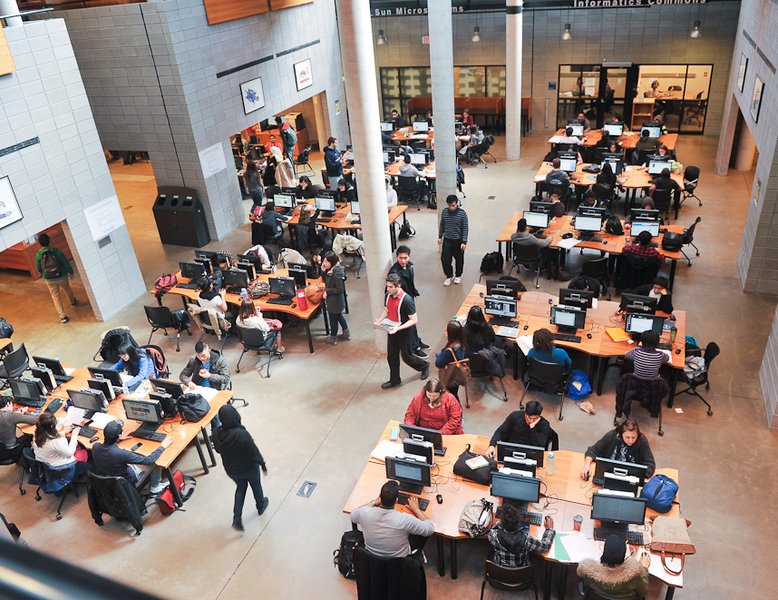By Cynthia Zheng, Writer
What does space mean to you? According to Dictionary.com, it’s a noun: the “expanse [where] material objects are located and […] events occur.” But it’s more than that sterile definition—it’s what constantly surrounds us, what we inhabit, and thus part of our mental and physical experience.
The Innovation Hub has conducted many projects examining the experience of space. Examples include Transforming the Instructional Landscape, Chill Spots, and the New College Dining Hall and Clara Benson Pool Gallery redesigns. Through this work, we’ve seen how the physical environment impacts us.
Learning Spaces
Students come to campus to learn. In the classroom, they are affected by physical features: windows, good lighting, and reasonable temperatures make them comfortable enough to engage. Conversely, they may get distracted when these elements are missing.
Furniture also interacts with learning style. In classes with open discussions, flexible furniture—round tables, movable chairs—lets students move around and share ideas. Thus, the classroom becomes less like a traditional lecture space, with one instructor broadcasting to many students, and more like a place of collaborative ideas and growth.
By increasing classroom collaborations, spaces encourage students to seek support and help each other. Connections can be made online or in person—by sitting around a table to have a discussion or by displaying student comments on real-time discussion boards.
Despite these exciting possibilities, not every student reacts to the same learning style. Thus it is crucial to accommodate students who feel more comfortable with alternate learning methods. By reaching out to all students, we better understand how to fit classrooms to their needs.
When spaces are adapted to student needs, we create an accessible learning culture. At the same time, learning culture affects how we use space. They go hand in hand; we cannot design one without thinking about the other.
Community Spaces
Just as physical spaces and learning are intertwined, physical spaces and community are equally connected.
In a vibrant community, members feel like they belong. Spaces foster a sense of belonging by encouraging social interactions. First, a comfortable environment puts students at ease so they can connect with each other. Second, a flexible layout lets them rearrange furniture to start conversations.
Students also feel a sense of belonging when they know they are allowed to be in a room. Explicit markers of permissions reassure them that spaces are for them and that they need not feel like intruders.
Finally, versatile spaces build community by inviting students to work on different activities, so they can return to a home base no matter what they are doing.
To help build community spaces at UofT, the Innovation Hub proposed the idea of Chill Spots and developed some design guidelines for them. This idea inspired the Provost’s Student Spaces Enhancement University Fund, which provides money to develop spaces “responsive to diverse student needs.”
(To learn more, check out the Chill Spots report. And find out more about the Fund through the Student Spaces Enhancement Call for Proposals.)
Interconnected Space
Space is a physical thing—a set of dimensions in the world—but it is also a metaphorical thing—room to learn and room to belong. The physical and metaphorical affect each other.
Though I have divided learning and belonging into separate sections, they are also interconnected. As we saw above, social interactions can help us learn, and shared learning provides a basis for us to socially connect. The classroom teaches us best when it welcomes us, and the lounge fosters learning by bringing us together.
What spaces do you use throughout the day, and how do they affect the way you learn and play?
Further Reading
To learn more about our previous projects on space, read our newest report on the Faculty of Kinesiology and Physical Education’s student space, as well as our past work on Transforming the Instructional Landscape, Chill Spots, and the New College Dining Hall redesign.

0 comments on “The Many Dimensions of Space”